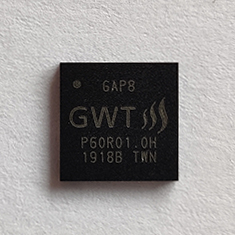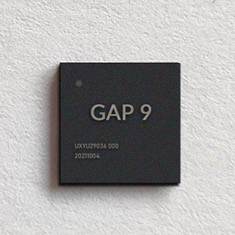We are a fabless semiconductor company, based in Grenoble, France. We design highly efficient and easy to program ultra-low-power RISC-V processors. They interpret and transform rich data sources such as images, sounds and radar signals using AI and signal processing.
Our application processor GAP8 enables embedded machine learning in battery-operated IoT Sensors. It allows image sensors for applications like people counting and attention awareness to run for years on a single AA battery.
Our second-generation GAP9 processor revolutionises TWS products with ultra-low latency noise cancellation, neural network-based background elimination and 3D sound.
AI and DSP processors for energy-constrained edge devices
GAP8

AI processor GAP8 is in production now powering a new generation of IoT Sensors.
Read more >>
Available in our store >>
GAP9

GAP9 combines ultra-low latency filtering with DSP and NN acceleration to power the next generation of hearables and IoT devices.
Read more >>
Enabling ANC in Open-Ear earbuds beyond Apple
Open-ear earbuds are an emerging design that has recently gained much visibility with the launch by Apple of their AirPods 4. The open-ear design provides comfort for extended use and enhances situational awareness by allowing ambient sound to enter the ear canal. >> Read more
What our partners say

“GAP9’s flexibility has allowed us to quickly port our market leading adaptive ANC solution onto it with great performance and power consumption results.”

“Thanks to the power of the GAP9 processor, the Deep Hearing algorithm delivers best-in-class, real-time, low-latency speech enhancement technology.”

“IDUN audio’s dynamic spatial audio (DSA) platform allows for a vast amount of configuration possibilities. Having an application processor like GAP9 available really allows us to demonstrate the full extent of the DSA platform’s possibilities. At the same time, we are able to keep the power consumption low enough to run comfortably inside wireless headphones.”

“Our team is excited about OmniSpeech’s Gap9 availability because it allows us to seamlessly leverage our most powerful AI speech algorithms on compact, low-power devices. This enables us to deliver superior speech performance and noise suppression in a wider range of applications without compromising on efficiency or quality.”

“Greenwaves’ GAP9 has enabled us to bring our cutting-edge, realtime speech enhancement algorithms to headphones and other wearable devices.”

“The power of GAP9 enables new ways to make music accessible to everyone.”

“GreenWaves’ GAP9 chip transforms the audio experience with its parallel architecture including lots of processing power, while still being energy efficient enough for long battery life. GAP9 enables new AI-driven features to be combined with proven audio signal-processing solutions, which for Elevear means we can bring our smart transparency, adaptive ANC, as well as our Dyno technology for natural head rotation audio compensation to the next level.”

“We were able to port Cyberon’s versatile, extendable voice command recognition engine, DSpotter to GAP9 in under a couple of weeks and are achieving the best energy efficiency that we have seen on any processor.”

“GreenWaves’ GAP9 represents a game-changing advancement in ultra-efficient low-power AI and DSP processing. Our collaboration with GreenWaves enables cutting-edge speech enhancement software in the smallest devices, fuelling a revolution in AI-powered audio processing.”

“Greenwaves’ GAP9 enables Gaudio Lab’s JustVoice to provide its users with clean and crisp real-time noise removal unlike any other. We are able to implement products for some truly remarkable AI audio magic, with the highest potential unlocked.”

“Thanks to the power of the GAP9 processor, REALSONIX ™ algorithms deliver the best immersive sound for optimal performance across earbuds, wireless speakers, and soundbars.”

“GreenWaves’ GAP9 is extremely powerful, offering exceptional capabilities for low-power AI and DSP processing. GAP9 enables high-quality, low-latency, real-time voice and music separation on portable devices such as hearables and speakers.”
















